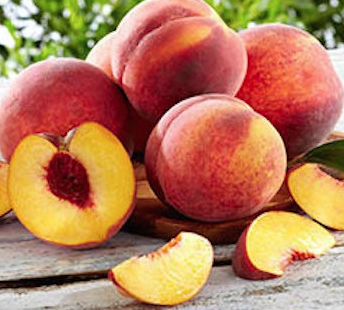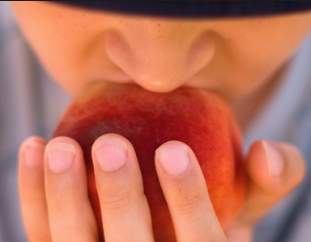I blame it on the canned peaches of my childhood, the soft grey masses of syrupy, sugary fruit that tasted of metal and stale water. With the texture of dense, soggy bread and the viscosity of 10W40, there was an overwhelming feeling of queasiness every time I heard a can being opened and slid into a bowl, like a gator sliding back into the swamp.
When my mother canned fresh peaches, the results were only marginally better, which leads me to believe that the peach should never be canned or bottled. She was a good cook, and I figured that if she couldn’t make canned peaches work, who could? I would probably have more success bottling sunshine than accomplishing a successful capture of the flavor, texture and lusciousness of a fresh peach, and therein lies my dilemma.

I love fresh peaches. I love grilled and roasted, baked and poached (although poached skirts very close to canned when texture is considered). A ripe peach is tartness and honey, chew and suppleness.
The skin should be warm, never from the fridge, and the first bite should spray and dribble, no chance for delicate nibbling.
Come fall I will look for the same characteristics from the local apples and pears. But right now, its peach season and there is no other fruit that’s better. Berries will come and go, melons are still a few weeks away, and judging by the baskets of peaches that stand as tall as I am they are the fruit that drives the engine right now.
A quick look reveals that most are from South Carolina, a quick word with my local growers suggest that the Kentucky fruit may be a bit sparse this year. The uneven spring we had may have limited the output of the fruit.
I’m okay with the regional versus the local. Especially when the flavor and richness of the fruit bring back some good summer memories of Kings Market peaches on Edisto Island. I also happen to believe that the marginally longer seasons south of us have a major impact on the quality of a limited number of items, peaches being among them. It gives the fruit a chance to absorb a bit more sunshine and that usually translates into a sweeter fruit. That being said, I eagerly await the extension of the peach run by our own fruit, hopefully within the next few weeks. It can only benefit us in the long run if we can get more peaches for a longer period of time.

If not canned, what to do with the fruit now? To me, the possibilities stretch from soup to nuts, quite literally from the beginning to the end of the meal. If pressed we can even extend it to the beverages we serve, although I’m not a big fan of that. The range of the peach is its hidden strength. Tart and sweet with only modest variations in each, it accepts flavors from all sides, and truthfully from most cuisines.
A great partner for dessert choices, it also goes surprisingly well with savory items, things like salmon, pork and chicken. Cooking methods bring out sugars (caramelization), or tartness (sliced and quickly sautéed). They can soften the texture by baking or create texture on the grill. Curried peaches, peach chutney, bourbon roasted peaches, smoked peach butter all add multiple layers of interest to a summer salad, soup, grilled meat or fish.
Peaches and cream chilled soup has many variations, most of them too sweet for me. I prefer fruit soups with some bite, so I will look to bring out the tartness of the peach, helping it along with some white balsamic vinegar. Peeling and pitting the peaches first, I roast them with some shallot and a bit of the white balsamic. When I get some color, I cool and puree the whole mixture. Want some sweetness, add reduced heavy cream. Like the tartness you’ve achieved, add buttermilk or reduced cream and sour cream. Only add what you need to balance flavor, texture and color. Season with some cinnamon, add a drop of fresh basil or mint and salt and cracked black pepper.
Grill some salmon and finish it with a bit of curried peach chutney.
Start by peeling some ripe peaches and tossing them with lemon and lime juice. Make a garam masala, a dry curry spice mix.
1 tsp nutmeg grated from the whole nut
2 tablespoons of caradamom seeds
1 tablespoon whole cloves
1 tablespoon whole cumin seed
1 tablespoon whole coriander seed
2 tablespoons black pepper
1 tsp of cinnamon
1 tsp of tumeric
Toast the spices whole, let them cool, and grind them with a spice grinder or in a mortar and pestle.
Once this is done, take a small onion and dice it. Coat it with some salad oil and slowly sweat the onion without coloring it. Add in a tablespoon of the masala and bloom the flavor together for several minutes. The remaining dry mix can be saved in a mason jar for up to a month.
Take two large peaches that have been marinating in lemon and lime, slice them thickly and add them to the pan with the onion and the masala. Add in a bay leaf, some apple cider vinegar, and some honey. If you want more heat, add in a diced jalapeno or better a serrano. You want a balance of tart and sweet with the peaches giving you both. Simmer this mix just until the peaches start to fray at the edges then stop and cool quickly. Preserve the texture of the fruit, do not let it turn to mush. Once cool, taste and adjust. The texture should be jam-like, the flavor at room temperature should be balanced. Spoon over the salmon just off the grill.

Speaking of the grill, how about some grill peach fritters with honey crème fraiche for dessert? First the crème fraiche. If you’re in a hurry mix two cups of sour cream with one cup of heavy cream, whisk in a half tablespoon of lemon juice and let sit lightly covered in a stainless-steel bowl for at least two hours at room temperature. Like the masala, this will keep in a mason jar in the fridge for several weeks. Once the texture and flavor of the crème fraiche are achieved, add in a little honey, just enough to balance the tartness of the crème fraiche.
When grilling peaches, I will often leave the skin on, I want the smoky flavor without the char. Split the peaches in half and take out the stone. Brush all surfaces lightly with olive oil and grill on an indirect or low-temperature part of the grill. You are looking for caramelization to bring some natural sweetness out. Once that’s accomplished remove from the grill to a covered bowl. The skins will peel as the peaches cool and then you can cut the cooked peaches up. When you are ready to make the fritters fill a small pot with enough oil to cook the fritters completely and keep the temperature in the pot at about 325 degrees Fahrenheit.
Make your fritter batter.
2 cups all-purpose flour
1/1/2 tablespoons baking powder
1 tablespoon sugar
1 tsp. Cinnamon
1 tsp. Salt
2 eggs separated, whisk the whites to firm peaks
1 ½ cups cream and milk in equal parts
Sift the dry ingredients, mix the wet ingredients minus the egg whites.
Fold wet into dry until just combined, and then fold in the whipped egg whites. This should produce a very light batter. In a separate bowl add some of the peaches, getting them as dry as you can. Fold in the fritter batter so it coats the peaches. If the mix is too runny, you may have to dust the peaches with flour before you batter them or add a bit more flour to the batter. Drop spoonsful of peach fitter batter into the hot oil and cook until golden brown and firm all the way through. Remove from oil, drain briefly, dust with powdered sugar if preferred and serve with your crème fraiche.

John Foster is an executive chef who heads the culinary program at Sullivan University’s Lexington campus. A New York native, Foster has been active in the Lexington culinary scene and a promoter of local and seasonal foods for more than 20 years. The French Culinary Institute-trained chef has been the executive chef of his former restaurant, Harvest, and now his Chevy Chase eatery, The Sage Rabbit.
To read more from Chef John Foster, including his recipes, click here.
























